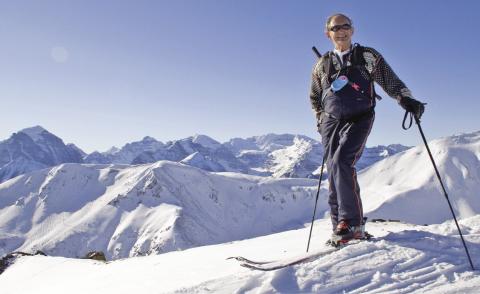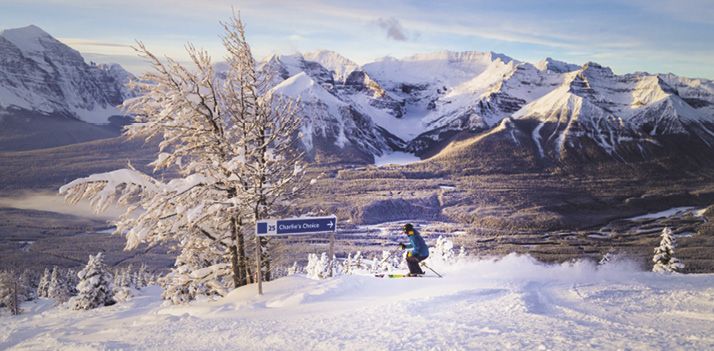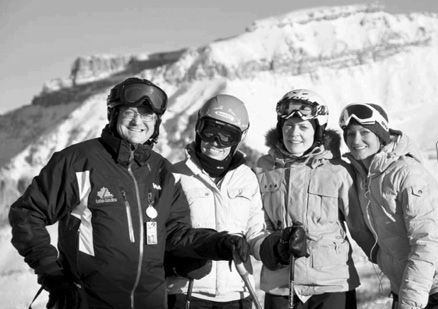
By Lori Knowles
Charlie Locke's wild ride as one of Canada's few remaining independent ski area owners
We give names to eras: Elizabethan. Georgian. Victorian. Edwardian. One wonders if the final decades of the 20th century—a sweet, progressive, positively thrilling age for Canadian skiing—will be remembered as Lockean. As in Charlie Locke, among the last of the independent ski area owners. This proprietor of Banff’s Lake Louise Ski Area is a businessman, oilman, family man, cattleman and meticulous numbers runner, as well as a gambler unafraid of hard work and massive risk.
Photo above: Credit Whyte Museum

McKerrell photo/Lake Louise Resort
He’s not a large man. While he’s an Alberta rancher, the ridgeline of the Rockies ringing his backyard, he is more wiry than his heavyweight reputation in the Canadian ski industry suggests. Locke is comfortable in vintage ski sweaters and heavy-treaded hiking boots, a thatch of his unruly hair brushing the collar of his rumpled turtlenecks. He’s as at home talking fresh-baked pies and Chevy trucks as he is talking spreadsheets, options and stocks. One story spills into another in an easy-to-listen-to patter, and the subject matter is fascinating, funny and wildly mixed. One minute he’s discussing business strategies during economic downturns, then friendships with prime ministers, then traverses of the Great Divide on skis with only half a peanut for lunch.
Now in his 70s, Locke is not just the owner of one of Canada’s largest ski resorts. He’s counted among the country’s top mountaineers, a vocation he’s nurtured since age six. His earliest memory is of coating a pair of $7 skis with Johnson floor wax for a ski trip to Banff’s Temple Lodge. The year: 1953. Knowing nothing about skiing, his father lashed little Charlie’s boots to his skis with a leather cord and sent him off on a five-mile run, hoping for the best. “That was the last time I really cried,” Locke says. “Snow built up under my skis in a big clump. Everyone left me behind.” He improved his technique in his teenage years, a bit. “At Mount Norquay, when they had three rope tows, I learned to turn left better than I did right because we had to get back into the line.”

A childhood friendship with Don Gardner shaped Locke’s life. Gardner’s father, Smitty, counted Olympians and mountaineering masters among his friends. (Hans Gmoser, the Austrian-born heliski pioneer and founder of Canadian Mountain Holidays, was a pal.) Smitty’s friends outfitted the boys with cast-off equipment, including old boots and mismatched skis of different lengths. They began skiing competitively in combined events (downhill, cross-country and jumping) with no training, just loads of guts. “I can still remember standing at the top of the ski jumps at Norquay looking down,” Locke says. “I was thinking, ‘I can figure this out.’ There are 15 to 20 people in the lineup, and I’m the only one speaking English. ‘Nils! Lars! Sven! Charlie!’ the organizers called. I went down the ramp and over the lip, sticking my arms ahead of myself. I landed and I didn’t fall. I just wanted to survive, that’s all I cared about. I knew I wasn’t going to win against Nils and Lars.” Later, near what was to become his own World Cup downhill course at Lake Louise, Locke remembers shouting, “Holy Cripes! How many turns should I make between the gates?”
The friendship with Gardner fostered a love of mountaineering. The two boys crafted their own climbing tools, read how-to books and ventured out with no real safety equipment, no pre-set plan and no word to their parents as to their route. Once, on a forced night out, spent on a cold and wet rock ledge, Locke’s knickers froze after he took them off. “I pounded them with a hammer to get them back on,” he told Chic Scott, of Banff’s Whyte Museum, in a 2020 fireside chat. It was during those trips with Gardner that they perfected “hard-assing”: glissading avalanche chutes to descend a mountain after a climb.

having a monopololy." MKerrell photo.
By 1965, at age 19, Locke and Gardner ventured out on a trek that’s never been repeated: They climbed and skied 23 Banff-area peaks in six and a half days, including the famed Ten Peaks, visible from the top of Lake Louise. Scott called it one of “the greatest mountaineering achievements ever in the Rockies.” Locke completed the first winter ascent of Mount Hungabee in 1966, Mount Stephen in ’71 and Mount Forbes in ’72. In the winter of 1967, Locke, Scott, Gardner and Neil Liske embarked on a 21-day traverse of the Great Divide with barely enough food. “I had half a peanut for lunch and the other half for supper,” Locke told Scott. Says Charlie now: “I think I was nuts.”
Maybe not so nuts. In fact, Locke was pretty damn bright. He was buying and trading stocks by the age of 12. As a student of commerce at the University of Alberta he sported horn-rimmed glasses and a knack for reading spreadsheets. His father, who owned several businesses and a dairy farm, encouraged him to work for a bank. So between first ascents and becoming one of the first Canadian-born certified mountain guides, Locke studied numbers hard. Upon graduation he sought jobs at brokerages. Within months he was a securities analyst specializing in oil. “I’m not going to say I’m a gambler [though he has said that on record in the past], but I certainly enjoyed buying and selling stock,” notes Locke.

daughters Kimberley and Robin, who
are vice presidents of the resort.
And that’s when he met Rodney Touche, the general manager of Lake Louise Ski Area, who came to Locke in 1974 looking for money for new lifts. Locke then became a minor shareholder. Around 1980 he went all in, buying a majority stake. “I was a financial analyst,” he explains. “I would read balance sheets as a hobby. I could see that compared to the oil business, the ski business wasn’t so bad. All cash; lift tickets were not a commodity like oil or coal, they don’t go up and down, only up every year; there was a huge number of customers; and being inside the national park was like having a monopoly—no one could build next to you.”
And that wasn’t all. “Skiing was recession proof,” he says. “With holidays every year in good times and in bad, and unemployment had no impact on visitation.” Plus, Locke says, as a “granolahead” he got along with Parks Canada. “They’d look at my history and say, ‘He’s not a bad guy. He won’t squeeze every last nickel out of the ski resort.’”
Pretty damn bright, indeed.
Through the ’90s, Locke set out on an ambitious quest, snatching up cash-starved ski areas in Alberta, British Columbia, even Quebec. “I bought Nakiska after the [1988] Olympics for $1 [plus assets] because the provincial government stopped subsidizing and they were going to shut it down,” he explains. “I bought Fernie because it had lots of snow. I bought Stoneham and Mont-Sainte-Anne for the marketing advantage.”
This rapidly growing posse of ski areas became known as the Resorts of the Canadian Rockies (RCR), and it got lots and lots of press. It’s no secret Charlie Locke’s ride as boss of this herd was akin to riding a bull. He says he learned from the greats, including Dave McCoy of Mammoth, who taught him about snow farming and fencing to stop the snow from blowing away. But all was not always well. Wrote George Koch in Ski Canada magazine, Locke’s management style drove “opponents bananas, middle managers muttering incoherently and journalists hitting record.”
Capital improvements, notably new lifts, overextended the RCR credit line. In 2001, the bank called in a massive loan, and Locke fell off the bull. He was relieved at first to pair up with financier Murray Edwards, an oil and gas investment banker, whom Locke calls “the smartest man I’ve ever known.” Edwards infused RCR with cash and Locke carried on, but, like many shiny partnerships, this one lost its luster fast. Locke didn’t agree with Edwards’ management style. Worse, he couldn’t come up with enough cash to hold up his end of the partnership. By 2003, the two parted ways and Locke was out of RCR. His saving grace: a five-year buy-back option for his first love—Lake Louise. He stole away from the ski industry for a few years to raise capital through ranching, oil and gas, then in 2008 exercised his option to buy back Lake Louise.
Now, in 2023, Locke is one of the few remaining independent owners of a major North American ski area. “I can never retire,” he likes to say, “because I’ve never had a job.” 
Regular contributor Lori Knowles is managing editor of Ski Canada magazine.
